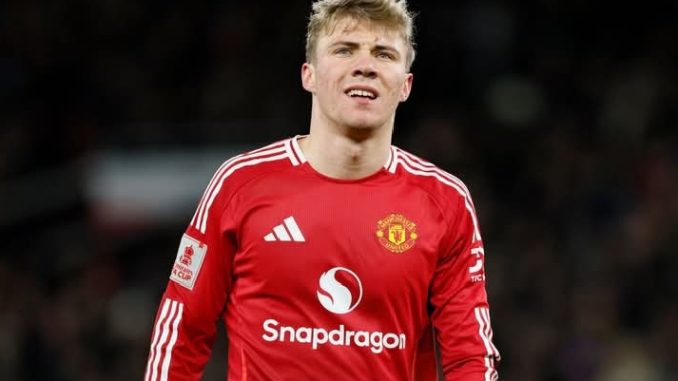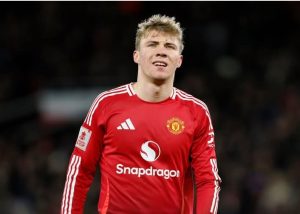
Benni McCarthy Reflects on Harry Kane’s Departure and Manchester United’s Decision to Prioritize Rasmus Højlund
Benni McCarthy, the former striker and current coach at Manchester United, has opened up about the club’s decision to pass on the opportunity to sign Harry Kane last summer, opting instead to invest in Rasmus Højlund as their future focal point in attack. McCarthy expressed his admiration for Kane, calling him the “complete package” in terms of his ability, leadership, and consistency, but revealed that the club’s management ultimately made a strategic decision to focus on the long-term potential of Højlund, rather than pursuing both players.
In an interview, McCarthy explained that while Kane’s reputation as one of the world’s top strikers was undeniable, the club’s hierarchy felt that Højlund, with his age and potential for growth, would ultimately be a more valuable asset in the long run. The decision to stop pursuing Kane and instead secure the services of the young Danish forward has been a topic of much discussion among Manchester United fans, with many divided on whether it was the right call. However, McCarthy’s insights provide a glimpse into the club’s strategic thinking behind the move.
Harry Kane, who had spent his entire career at Tottenham Hotspur and firmly established himself as one of the best strikers in world football, was heavily linked with a move to Manchester United for much of the summer transfer window. With United in desperate need of a clinical forward, Kane seemed like the perfect fit, offering experience, goals, and leadership to a side that had been missing a true talisman up front. However, as the window wore on, the prospect of signing Kane began to fade, and Manchester United ultimately turned their attention elsewhere, eventually securing the signature of Højlund from Atalanta.
McCarthy, who has worked closely with United’s attacking players, explained that the club had a different vision for the future of their forward line. While Kane’s experience and proven goal-scoring record made him an attractive option, the club believed that signing him would not align with their long-term plans. Instead, they focused on bringing in a younger player in Højlund, who, despite his lack of experience at the very top level, showed immense potential and promise. The decision to go with Højlund was not based on a lack of respect for Kane’s ability, but rather a desire to build for the future and develop a player who could lead United’s attack for years to come.
The decision to prioritize Højlund over Kane has not been without its share of controversy. Kane’s eventual move to Bayern Munich for a substantial fee demonstrated just how highly regarded the English striker still is. In contrast, Højlund’s arrival at Old Trafford has been met with mixed reactions. While the young forward has shown glimpses of his talent, there is a sense that he still has a lot to prove before he can consistently perform at the highest level. For many fans, the idea of having a player like Kane, who was proven and ready to deliver immediately, seemed like the safer option.
However, McCarthy’s comments shed light on the bigger picture and the rationale behind Manchester United’s decision. The club’s leadership was not simply looking to address their immediate needs but was instead considering the long-term trajectory of the team. By opting for Højlund, Manchester United invested in a player with the potential to develop into a world-class forward. Højlund’s youth, versatility, and ability to grow alongside the team’s evolving squad made him a valuable asset for the club’s future, even if it meant forgoing the more immediate rewards that Kane could have provided.
There is no doubt that Kane’s pedigree as a top striker made him an appealing choice for United. He has been one of the most consistent goal-scorers in the Premier League over the past decade, and his leadership qualities were well-documented during his time at Tottenham. However, the financial considerations of bringing in a player like Kane—who would have commanded a hefty transfer fee and wage package—played a significant role in the club’s decision-making process. Kane’s age, combined with the high cost associated with signing him, made it more difficult for United to justify the move when they could secure a younger and more cost-effective alternative in Højlund.
The signing of Højlund was also seen as a key part of Manchester United’s broader rebuilding strategy under manager Erik ten Hag. The club has been undergoing a transformation in recent seasons, with a focus on bringing in young, dynamic players who can contribute to the team’s long-term success. Højlund, with his physical attributes, technical ability, and high ceiling, fit the profile of the kind of player the club wanted to build around. United’s decision to prioritize his signing over Kane was a signal that the club was looking beyond short-term fixes and instead aiming for sustainable growth and success.
McCarthy’s comments also hint at the importance of strategic planning in football transfers. In a market where marquee signings often dominate headlines, the decision to invest in younger talent may not always be the most glamorous option, but it is one that can yield long-term benefits. Højlund’s arrival at Old Trafford represents the club’s commitment to investing in youth development and creating a squad that can compete at the highest level for years to come. The risk of opting for a less experienced player may not pay off immediately, but if Højlund develops as expected, he could become a key player for Manchester United in the future.
Of course, the success of this decision will depend on Højlund’s ability to adapt to the demands of the Premier League and consistently deliver on the promise he showed in Serie A. The young striker has shown flashes of his potential, but the reality of playing for a club like Manchester United is that the pressure to perform is immense, and expectations are high. The challenge for Højlund will be to continue improving and proving that United made the right choice in signing him over Kane.
As the season progresses, it will be interesting to see how Højlund develops under the guidance of Erik ten Hag and whether he can fill the void left by United’s search for a true striker. If Højlund can live up to his potential, the club’s decision to pass on Kane may be vindicated. On the other hand, if the young forward struggles to adjust to the Premier League, the decision may come under increased scrutiny.
In conclusion, Benni McCarthy’s reflections on Manchester United’s decision to pass on Harry Kane in favor of Rasmus Højlund offer valuable insights into the club’s long-term vision. While Kane was undoubtedly the more proven option in the short term, the club’s focus on securing a younger player with greater potential for growth highlights their commitment to building a sustainable future. The decision may not have been popular with all fans, but it aligns with the club’s broader strategy of investing in youth and planning for future success. Whether Højlund can fulfill the promise that made him United’s preferred choice remains to be seen, but the club is betting on his potential to lead t
he line for years to come.

Leave a Reply